|
The stream running like a chorus of cicadas woke me up. In the dark and
silent world the sound is very clear to the ear, or even a little noisy.
With the eyes closed, I keep myself for a while in the stream-sounding
natural world. It is at 5:00.
Breakfast at 7:30 in the dining hall. The staff takes good care of Emiko.
She becomes pleasant to see rice-porridge dish. The same with me, though
at home every breakfast is smoothie-juice, coffee, thin bread and yogurt.
I feel relieved both in body and mind to be honest.
After back to the room, I have been thinking in the seat about how to spend
the day looking over the stream. I have not yet totally abandoned the visit
to Matsumoto Castle in mind.
Whether is it raining or not? Anyway it seems very much like threatening to rain over the window.
Thinking this way, then it has truly begun to rain considerably. It must
definately be rainy the whole day today both according to the weather forcast
and the real sky.
Looking at Emiko watching TV quietly, I finally decided to walk around
the hotel and see the other sights here than yesterday, and to take soba
lunch at another Japanese restaurant.
On the other hand, Emiko, all of a sudden, like having made a firm decision,
said to me, "Shall we go to Matsumoto Castle from now if there is
still a bus service?"
The traffic company called "Alpico Traffic" has a connection
between Shirahone Spa and Matsumoto urban area. A bus service until Shin-shimashima,
and a train service there to Matsumoto Station. But the bus service is
only four times a day with only a 10:21 bus to Shin-shimashima in the morning,
and the last one back from there is at 15:30. Fortunately or not, even
this service is until tomorrow this year.
The bus stop was within 10 minutes on foot. We did not have any trouble.
The bus started on time and drove along the foot of Mt. Norikura to Shin-shimashima,
where we were going to transfer to a train for Matsumoto Station.

The road was steeply downward and winding from the very beginning, and
the bus naturally jolted right and left. The rain became full-scale. Even
if the carsickness medicine helps Emiko this time, it is not a pleasant
thrill for us.
But, look at the scenery over the window until Sawando for 10 and some
minutes! The surroundings of a steep stream roaring a sound are really
a simple chain of woods. The red leaves are over with carpets of fallen
leaves under dead trees, ..., a secluded district in the mountains like
a drawing.
From this area houses began to appear, and the river became widened with
the stream gentle.
We are at Sawando Terminal, seemingly in a large village. Here the people to go to Kamikochi Heights change buses.
We four people stay in the bus.
We pass through tunnels one after others from here.
A waterfall has come to our eyes. The basin looks navy-blue. The view around
the Nakawado Dam under it is beautiful. There are red leaves left from
this area.
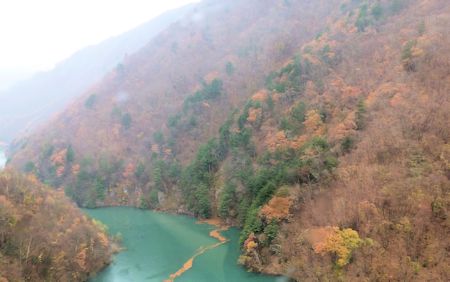
Driving around Hounzaki, the automatic announcement in the bus let us know
Nomugi Ski Resort was near. Then according to it, "The Nomugi Pass,
too," which is familiar to me for the sad history of women factory
workers by the movie I used to see in my youth. I forgot most of the detail,
but it is the fact the movie was heartbreaking.
Was this mountain pass in that movie? It is a winding steep slope even
now, beyond imagination during Meiji and Taisho Period. During those days
girls around this area walked up and down over this pass for seasonal working
at Suwa district of raw silk industry.
It was written in 1968 by Yamamoto Shigemi as a non-fiction story and then
was filmed.
From Shirahone to Shin-Shimashima, Other Pictures
Arrived at Shin-shimashima Terminal at 11:15.

Transferred to the train for Matsumoto starting at 11:30.
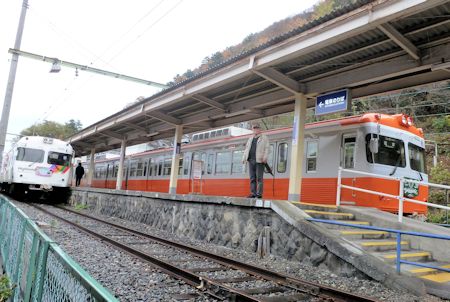
For about 30 minutes in the train, I had a lively talk with a young gentleman
of the age 29.
I knew he had been with our couple in the same bus, but I greeted him firstly
here and then a long talk started.
He says he is from Tokyo and has been working here at Shirahone since two
years ago. Why? What kind of work and where? .....? I have no interest
in any background check, so we just introduce each other. When one topic
ends, the next topic follows immediately, and so on, so on.
Our talk did not stop at all for 30 minutes until the train arrived at
Matsumoto Station at 12:00.
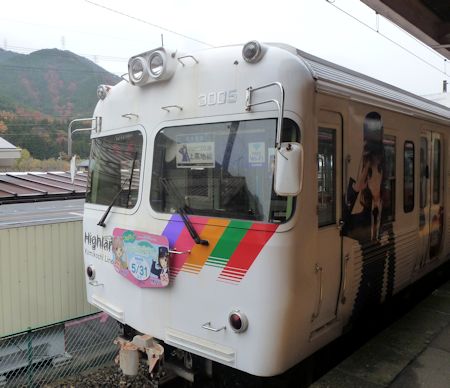
Our couple entered the information office in the station and asked the
way to Matsumoto Castle and any soba restaurant of recommendation on the
way.
A staff lady, showing a map, said, "You will get there in 15 minutes
along this road. I personally recommend Miyota."
There was a line at the entrance to "Miyota", a Shinshu-soba
restaurant. We waited for 30 minutes after all.
I ate simple zaru-soba noodle, while Emiko tororo-soba (grated-yam-soba).
Due to this delay, we got to the castle late at 13:10. Even so, we had
50 minutes to see its inside. Emiko, once visited here before, decided
to walk around the garden, and I entered the castle by myself.
I just made my effort to climb up rather than went up to the keep on the
6th floor. I never had such a hardship. The steep steps and large difference
in level. In addition, the width of the steps became extremely narrower
from the 4th floor, which increased risk.
Aside from the handicap of my left lower body, I was totally exhausted
when finished climbing. Though I hoped to take pictures of what I wanted
at first, my true feeling gradually became nothing but tired with no such
idea. I wonder how other people managed themselves.
Appearance
The handout explains as follows.
| Origin |
The origin of Matsumoto Castle goes back to Fukashi Castle, which was built
at the beginning of the Eisho Era, in the civil war period.
During those troubled times, Lord Ogasawara in Shinano, moved his manor
house from Igawa to the Hayashi district at the eastern foot of the mountain.
At that time, the center of the Matsumto plain was called Shinano Fuchu.
Lord Ogasawara's retainers protected themselves by building their houses
around Hayashi Castle, the new manor house of their lord.
Fukashi Castle was built in front of Hayashi Castle at around the same
time to protect the front of the manor house.
After that, Takeda Shingen of Kai chased away Lord Ogasawara to create
a strongpoint for the conquest of Shinano.
Then, in year of 10 of the Tensho Era (1582), Ogasawara Sadayoshi recaptured
Fukashi Castle by taking advantage of the protectors letting down their
guard during the Honnoji incident. He then changed the name to Matsumoto
Castle. |
|
| Construction of Tenshu |
After Toyotomi Hideyoshi dominated the whole region by defeating Hojo Ujinao
at Odawara Castle in year 18 of the Tensho Era (1590), he allocated the
Kanto area to Tokugawa Ieyasu.
Ogasawara Hidemasa, the lord of Matsumoto Castle at that time, also moved
to Shimoosa in Kanto by following Ieyasu. Hideyoshi appointed Ishikawa
Kazumasa as the new lord of Matsumoto Castle.
Kazumasa and Yasunaga, the father and the son, maintained the castle and
the town. Yasunaga built, not only the three towers, including the tenshu (donjon tower), inui-kotenshu (small tower in the northwest), and watari-yagura (connecting scaffold), but he also built the goten (residence), taikomon (drum gate), kuromon (black gate), yagura (scaffold), and hori (trench).
He secured honmaru (the main wing) and ninomaru (the second wing), gathered warriors in sannomaru (the third wing), built up the infrastructure in the town, and created
the sub-floors in Matsumoto Castle, much as they are today.
It is estimated that the towers were built during years 2 and 3 of the
Bunroku Era in Yasunaga's time in power (1593-4). |
The visiting time was good enough for me including the walk around the
garden.
Matsumoto Castle, Other Pictures
- - - - -
It was still a little over 14:00. Since the train from Matsumoto Station
was going to start at 14:46, we took a comfortable walk, opening an umbrella
in the sprinkling rain and not feeling pressed for time. For myself, I
was actually standing the dull pain of the left lower body.
In Matsumoto City Area, Other Pictures
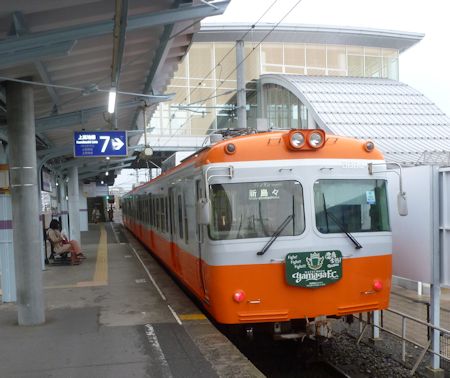
The train arrived at Shin-shimashima at 15:20. And our bus started there
at 15:32, getting to Shirahone Bus Stop near our inn at 16:53.
Enjoyed a hot spring both in the large bathroom and the open-air bath.
Then gorgeous dinner from 18:30.
I thanked Emiko for today and drank a toast of beer in a mug tonight. Main
dish is beef stake and sashimi.
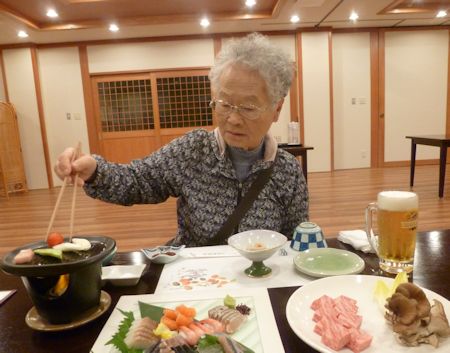
Both of us were satisfied with moderate eating.
|